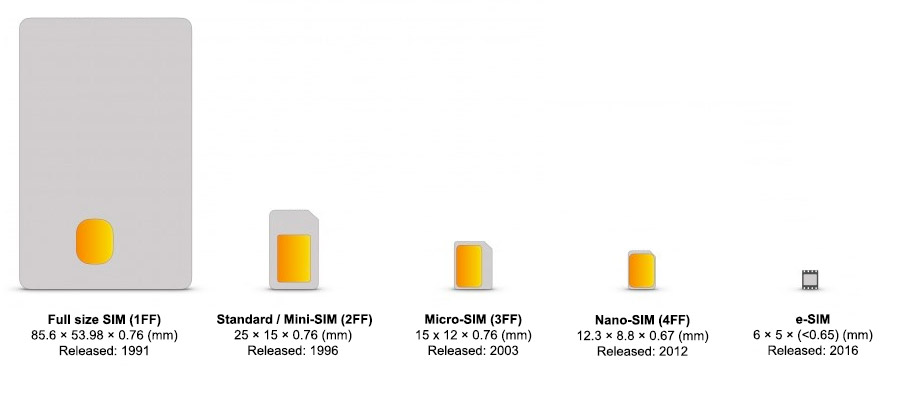A Subscriber Identity Module or Subscriber Identification Module (SIM), widely known as a SIM card, is an integrated circuit chip that is designed to identify your mobile carrier.
SIM cards contain network-specific information that is used to authenticate and identify subscribers on the mobile network and since their initial release in 1991 have been made smaller with every new format.

From left to right in the above image we have; Full-size SIM (1FF), mini-SIM (2FF), micro-SIM (3FF), nano-SIM (4FF) and e-SIM.
- Full-size (1FF, or 1st form factor) SIM cards were the first SIM cards to appear in 1991 and were the size of credit cards at 85.60 mm × 53.98 mm × 0.76 mm.
- Mini-SIM (2FF) SIM cards were introduced in 1996 and have the same contact arrangement as the full-size (1FF) SIM card. The 2FF 'mini-SIM' is distinctly smaller in size than the Full-size SIM with dimensions of 25.00 mm × 15.00 mm × 0.76 mm. Some networks refer to the 2FF mini-SIM as the Standard SIM or Regular SIM. This also happens to currently be the size SIM card that most of our range of tough phones accept, whether they are single-SIM or dual-SIM devices.
- Micro-SIM (3FF) cards were introduced in 2003, with dimensions of 15 mm x 12 mm x 0.76 mm the Micro-SIM was smaller still than the Mini-SIM. The Micro-SIM has the same contact area as the Mini-SIM (and therefore Full-size SIM) and is the same thickness as both of it's predecessors. The Micro-SIM is a card that a majority of modern day smartphones operate with, the immensely popular iPhone 4 was the first mobile phone to use the new form factor in 2010 (seven years after it was created), later followed by handsets like the Nexus 5, Samsung Galaxy S3/4 and Sony Xperia.
- Nano-SIM (4FF) was made available in early 2012. Again, like with the iPhone 4 and Mini-SIMs it was an Apple device that first used the new 4FF SIM cards with it's iPhone 5, the Nexus 6 and Samsung Galaxy Alpha soon followed suit. So far this has been the smallest SIM card to date, measuring 12.3 mm × 8.8 mm × 0.67 mm.
- e-SIM (embedded-SIM) is a form of programmable SIM that is embedded directly into a device. The surface mount format provides the same electrical interface as the full size, 2FF and 3FF SIM cards, but is soldered to a circuit board as part of the manufacturing process. An eSIM can be provisioned remotely; end-users can add or remove operators without the need to physically swap a SIM from the device.
Regardless of which size SIM card you are using in your device each SIM card can store up to 250 name/number pairs and can also hold up to 50 SMS text messages.
As mentioned above most modern day smartphones use either a Micro or Nano-SIM while most tough phones use a Mini-SIM. However it appars that this generation of tough phones are starting to follow in the footsteps of their less rugged brothers with handsets like the new CAT S30 & CAT S40 now using Nano-SIMs.
Will we ever reach a time when SIM cards are a thing of the past? Possibly, but for now the SIM card in your phone is needed to connect your device to a mobile network.
The SIM card was part of a European telecommunications standard that was designed to separate mobile phones from the networks they connected to. This was done by moving all the necessary security and identification data onto a chip, embedding it into a piece of removable plastic the size of a credit card.
Each SIM card has a unique IMSI (International Mobile Subscriber Identity) number allocated to it, and it is this IMSI number that the GSM networks use to connect your mobile to another during a call, so when someone calls your mobile number they are connected to you rather than someone else - clever!